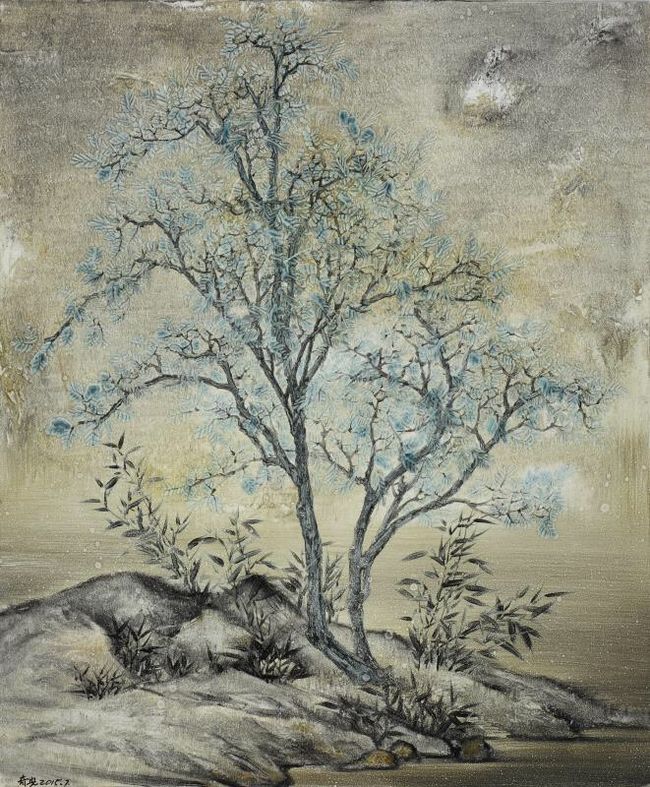--李奇安的艺术
– The Art of Li Qian
Two hundred years ago Hegel commented on the pursuit of perfection in the use of different materials, media and surfaces by the “naturally clever” Chinese: “Their preparation of varnishes, their working of metals, their porcelain manufacture and many other things, have not yet been completely mastered by Europeans.” (Neither have they been mastered since! R.R.) (Hegel: Philosophy of History, “China” chapter). In spite of the accelerated pace of modern life, hyperproduction and lowering of technical standards that goes with it, this quest for refinement and perfection has remained a preoccupation of some contemporary Chinese artists. Li Qian is certainly one of them. Though deeply rooted in the artistic tradition of his country, he also makes effective use of western traditions. Li Qian maximizes the potential of oil painting to create luminous and transparent forms and spaces to produce works of unique beauty,“simple, clean, pristine and transparent, with an air of dignity”, as he himself rightly describes them.
两百年前,黑格尔对于追求不同材料,媒介和表面的完美如此评论中国人:“他们对漆料的准备,他们的金属工艺,他们对瓷器和其他许多东西的生产,还没有完全被欧洲掌握。”(作者评论:即使到如今,欧洲还是没有完全掌握这些技术)。(黑格尔:哲学历史:“中国”章)。 虽然加速度的现代生活节奏,超量生产和技术水准的降低随之而来,对于一些中国艺术家而言,精益求精始终是当代中国一些艺术家最关心的问题。李奇安是他们其中的一员。他受传统中国文化根源的熏陶,同时将西方油画媒介做到完美利用,从而创造出通透的形致和空间从而制造出具有特有美感的作品“简单,干净,纯净,透明,同时赋予了一种尊严”正如他自己正确描述他的作品那样。
在李奇安作品中最让人惊诧的是他的持重,温柔地闪耀的,彩虹般变幻的色彩,就好像古代中国的镶嵌有螺钿的漆器在油画中被赋予了新的生命。这从奢华的中国古物中萃取的变幻的色彩,给予物体晶莹通透的质感,愉悦和纯净感,使人联想到玻璃窗上结的霜。确实,画面主题经常有冬的意境,比如梅花,竹子枝条,这两个传统中国的“岁寒三友 ”(松,竹,梅)中的元素。 梅花被描述成细腻的粉红和紫色晶体的结合体;竹叶也是凝结成晶体。但是,这些“冬天”的景致经常被一缕阳光所温暖,而且这些景象也被一只孤独的鸟儿赋予了苍凉的生机。画中传达了一种深秋或者冬日的忧伤情怀同时也明确地抒发了对卑微物体的脆弱和重要的感悟。类似的思乡情怀在元代喜剧家和诗人马致远的秋思(天净沙)中也有描述,这首诗按照李奇安的说法,给予了他强有力的灵感冲击和创作冲动:
What particularly fascinates in Li Qian’spaintings is above all their sober, gently shimmering, iridescent colors. It is as if the colors of old Chinese lacquers with their gildings and mother-of-pearl inlays have been given a new life in oil painting. This iridescence,extracted from the luxurious Chinese objects of old, has been infused into objects the crystalline transparence, crispness and purity of which remind one of the forms created by frost on aglass window. Indeed, the themes of Li Qian’swork often have winter associations like prunusand bamboo branches, two of traditional China’s “three friends of the Winter” (prunus, pine and bamboo). Prunus flowers are transformed into crystalline aggregates of a delicate pink and violet color; bamboo leaves are congealed into crystalline forms too. However, these “winter”sceneries are often warmed by a golden glow as if being illuminated by a setting sun and they are often enlivened by the melancholy presence of solitary birds. The atmosphere is replete with a kind of late autumn/winter melancholy, which also brings an acute awareness of both the fragility and importance of humble objects. Similar nostalgic feelings are found in the poem by Yuan Dynasty dramatist and poet MaZhiyuan, entitled Meditation in Autumn (TianJing Sha), a poem which, according to Li Qian’sadmission, has exerted a powerful inspirational force on his work:
“枯藤,老树,昏鸦;小桥,流水,人家;古道,西风,瘦马;夕阳西下,断肠人在天涯。”
“Withered vine, old tree, crows at dusk. Tiny bridge, flowing brook, humble cottages. Ancient road, cold wind, bony steed. Sun sinking West, a heart torn traveler at the end of the world”.
李奇安作品的一个显著的特点是几乎无处不在的光束。画家把它作为来自于西方的代表延伸、连接和光明未来的现代元素。因为他给自己最近的作品命名为“延伸系列”。 然而,矛盾的是他在他的作品中,甚至这些简单的元素也被赋予了清楚的中国意味。这些光线奇怪地聚焦于某一位于画面外的一点,这好像是一个令人欣喜的对统治西方艺术几个世纪但对于中国是舶来品的科学的透视的背离。正如中国式的三向投影透视及其对角倾斜,李奇安将光束倾斜的聚集引导我们的视线通向不可知的高层的梦幻世界。这些神秘的光束没有点亮而是将物体吸引到它们产生的源头。在画面中一群白色的天鹅奔向光线发出的地方是最好的解释。李奇安评价这些高傲的鸟儿:“当我看到天鹅飞翔,我觉得他们在带走我的灵魂,对于我来说,他们的飞翔象征着一种只有我们的祖先才能表达的自然流淌的能量和孤独感”。对等地,在西方传统中,可以类比的是白天鹅引领阿波罗去往亥帕波尼亚人居住的白雪覆盖的地方:这些鸟儿是高高飞翔,努力奔向清明澄澈境地的高贵灵魂的象征。
A conspicuous feature of Li Qian paintings is an almost ubiquitous presence of rays of light. The painter sees them as a modern element coming from the West signifying extension, connectionand brighter future. Because of them he has called his recent production “Extension Series”. Yet, paradoxically, in his paintings, even these simple elements are given an unmistakably Chinese interpretation. The rays are eccentrically focused, converging toward an invisible point situated outside the picture. This seems a welcome departure from the tyranny of central, “scientific” perspective which has dominated Western art for centuries but is alien to the Chinese spirit. Like the axonometric Chinese perspective with its diagonal slant, Li Qian’s obliquely placed sheafs of converging light rays lead our gaze towards some unknown dreamland beyond. These mysterious rays do not illuminate but rather attract, pull objects towards the source from which they emanate. This can be best realized in the painting in which a flock of white swans flies towards the source of these rays. Li Qian comments on these lofty birds: “When I watch swans flying, I have the impression that they are taking away my soul. For me, their flight symbolizes a natural and mysterious flow of spontaneous energy and the sense of loneliness that only our ancestors could express”. A parallel, from the western tradition, with the white swans that take Apollo to the snowy lands of the Hyperboreans can also be drawn: these birds are a symbol of noble souls which fly high in their striving for clarity and purity.
正如花朵和叶子在李奇安的画中一样,这些光束也聚集成一种形而上的静穆。这些光束甚至有种可以触及的品质。使我记起Jonathan Hay说过的在中国明清绘画中可以感知的色彩:“修饰需要光滑不仅仅是手可触摸的而且是可以看见的——对视觉有形的快感。对于让光滑变得可视,这需要和其他更加纯净的视觉品质相关联(比如, 色彩,作者注:J.Hay: Sensuous Surfaces, The Decorative Objects in Early and Modern China, ReaktionBooks, London 2010, p.109).
Like the flowers and leaves in Li Qian’spaintings, these rays of light are also congealed in a moment of metaphysical stillness. Moreover, they have a palpable quality of light that can be touched. I am reminded of what Jonathan Hay said about the palpable quality of color in decorative arts of Ming and Qing Dynasty China: “ … decoration requires smoothness not just to be available to the hand’s touch but also to be visible – a visual promise of tactile pleasure. For smoothness to become visible, it has to be associated with some other, more purely visual quality (i.e. color, R.R.;J.Hay: Sensuous Surfaces, The Decorative Objects in Early and Modern China, ReaktionBooks, London 2010, p.109).
李奇安在他的画中将他传统中国艺术的通感的经验更往前带了一步:他成功地将光和色彩变成了可视的物体,而且将它们转化成眼睛触及的感官享受,不是用手触摸而是用眼睛“摸”到。这是不易的成功。
Li Qian has in his paintings taken this synaesthetic experience typical of traditional Chinese art a step further: he has managed to make light and color not only objects of visual pleasure but to make them objects of tactile pleasure not to be enjoyed by the hand’s touch but by the “touch” of the eye. Not a mean achievement.
文章作者:阮诗寇博士
整理编辑:Luna
Luna 从事跨国企业管理与文化艺术交流活动数年,因其在意大利及美国公司任职的经历,与国外及国内画廊保持着很好的合作关系,接触北京及国外的多位知名艺术家,形成个人独特审美视角并积累了丰富的艺术策划及推广经验。
希望爱好艺术的朋友们,多多指教,并分享给更多的朋友,最重要的是记得评论与点赞哦,谢谢!






